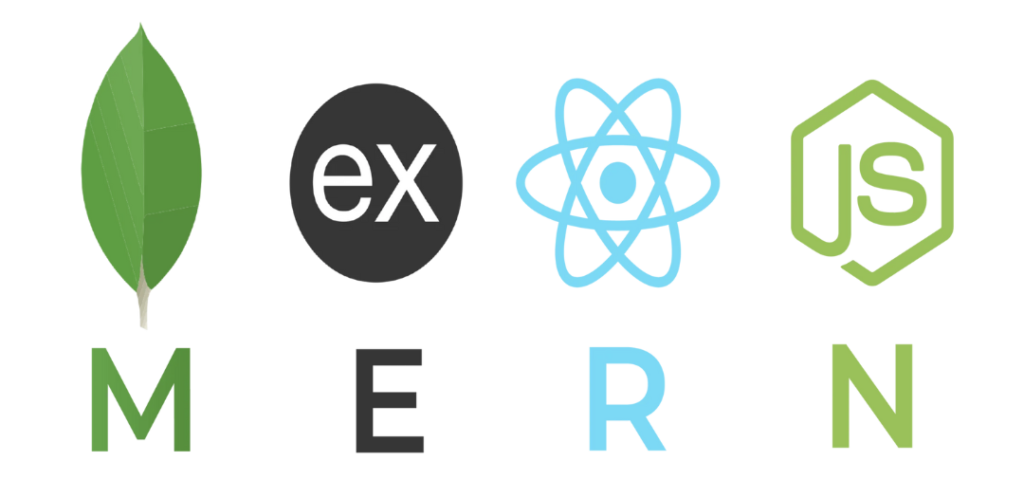
The MERN stack development services consist of MongoDB, Express.js, React.js, and Node.js—powerful tools for full-stack JavaScript development. Each component plays a vital role in the process:
MongoDB is a NoSQL database that stores data in a flexible, JSON-like format called BSON. It is known for its scalability and flexibility, making it suitable for handling large amounts of unstructured data.
A lightweight and flexible backend framework for Node.js that simplifies the process of building robust and scalable web applications. Express.js facilitates the creation of RESTful APIs, making it an integral part of the MERN stack development services .

A JavaScript library for building user interfaces. React.js enables developers to create reusable UI components, making it easier to manage and update complex front-end structures. It follows a declarative approach to building components, enhancing code maintainability.
A runtime environment that allows developers to execute JavaScript code on the server side. Node.js is event-driven and designed to be efficient and lightweight, making it an excellent choice for building scalable and high-performance server-side applications.
The MERN stack is a powerful and flexible combination of technologies that facilitates the development of modern, scalable, and full-stack JavaScript applications. Each component plays a specific role in the development process, and the seamless integration of its components enables developers to build feature-rich and performant web applications. Let’s explore the potential benefits of using this framework.

The entire stack uses JavaScript, providing consistency across the development process. Developers can use the same language for both frontend and backend, reducing context-switching and enhancing code maintainability.

MERN stack enables developers to work on both frontend and backend aspects of the application. This full-stack flexibility allows for a cohesive and integrated development experience.

Node.js, with its non-blocking I/O model, and MongoDB’s horizontal scaling capabilities contribute to the stack’s ability to handle scalable and high-performance applications.
While the MERN stack offers a comprehensive solution for full-stack JavaScript development, it’s essential to acknowledge potential pitfalls, especially when compared to Next.js. Here are some considerations when using the MERN stack.

The MERN stack might be overkill for small projects or simple applications. The full-stack nature of MERN involves setting up and managing multiple components, which can increase development time and complexity for smaller endeavors.

Learning and becoming proficient in all four technologies (MongoDB, Express.js, React.js, and Node.js) can be challenging, especially for beginners. Developers need to grasp both front-end and back-end concepts, which might lead to a steeper learning curve compared to more specialized frameworks.

Setting up and configuring each component of the MERN stack can be time-consuming, especially if you’re new to the technologies. Coordinating the integration of MongoDB, Express.js, React.js, and Node.js might require additional effort in terms of understanding dependencies and ensuring compatibility.

While React.js can be used to create dynamic and interactive user interfaces, search engine optimization (SEO) might require additional effort. Search engines may have difficulty indexing content generated dynamically on the client side, potentially impacting the website’s search ranking.

Next.js allows developers to render React components on the server side before sending them to the client, improving initial page load times and search engine optimization.
Next.js can generate static HTML files at build time, reducing the server load and ensuring fast loading times for end-users.
Next.js optimizes performance by automatically splitting the application code into smaller chunks, loading only the necessary components when needed.
Next.js is a powerful and flexible framework that extends the capabilities of React.js, making it easier for developers to build performant, SEO-friendly, and scalable web applications. Whether it’s server-side rendering, static site generation, or streamlined deployment, Next.js provides a comprehensive set of tools to address modern web development challenges.

Server-side rendering and static site generation contribute to faster initial page loads, providing a better user experience.

Server-side rendering helps search engines index content more efficiently, improving the website’s search engine ranking.

Simplified deployment: Next.js supports easy deployment to various hosting platforms, making it convenient for developers to publish and maintain their applications.
While Next.js offers many advantages, it’s essential to consider potential pitfalls, especially when compared to the MERN stack. Here are some considerations when using Next.js:

Developers familiar with React may need time to adapt to Next.js conventions and concepts, particularly when transitioning from client-side rendering to server-side rendering.

While Next.js offers a set of conventions that simplify development, some developers may find it restrictive compared to the flexibility of a custom-configured stack.
To sum up the points made about Next.js,
Choosing Next.js over the MERN stack emphasizes improved performance, simplified deployment, and SEO benefits. Next.js, a React-based framework, excels in server-side rendering (SSR) and static site generation (SSG), resulting in faster page loads and enhanced SEO. Its automatic code splitting optimizes performance, and its streamlined deployment process makes it more accessible than the MERN stack’s manual setup. While the MERN stack provides full-stack flexibility, Next.js offers a more focused approach, particularly suitable for projects prioritizing performance and SEO optimization. The decision between them depends on project requirements and development preferences.
